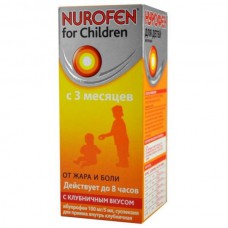Expiration date: 11/2026
The composition and form of issue:
Suspension for the reception inside (orange or strawberry flavor). 1 ml contains:
ibuprofen 20 mg
excipients: maltitol syrup water glycerol citric acid sodium citrate sodium chloride sodium saccharin orange flavor 2M16014 or flavouring strawberry xanthan 500244E excipient Polysorbate 80 domiphen bromide
in bottles of 100 ml, complete with a measuring syringe or a double measuring spoon for 2, 5 and 5 ml in a box of 1 bottle.
Description of dosage form:
Suspension white or almost white syrupy consistency with a characteristic orange or strawberry smell.
Description of the pharmacological action:
The mechanism of action of ibuprofen is caused by inhibition of biosynthesis of PG mediators of pain and inflammation.
The effect of the drug (in the form of suppositories) lasts up to 8 hours.
Indications:
For children from 3 months to 12 years:
- as antipyretic — ARI, SARS, influenza and other infectious and inflammatory diseases accompanied by fever postprevious reaction
- as a painkiller — pain syndrome of weak or moderate intensity (including headache and toothache, migraine, neuralgia, pain in the ears and throat, pain in sprains), etc.
Contraindications:
- hypersensitivity to ibuprofen or to any of the components of the drug, acetylsalicylic acid (or other NSAIDs)
- bronchial asthma, urticaria, rhinitis, provoked by taking salicylates or other NSAIDs
- the presence of a child with ulcerative lesions of the gastrointestinal tract
- active gastrointestinal bleeding, inflammatory bowel disease
- diseases of the blood (hypocoagulation, leukopenia, haemophilia)
- renal and/or hepatic insufficiency
- depression of hearing.
- deficiency of glucose-6-phosphate dehydrogenase
Side effect:
When using the drug, it is rarely possible to have the following side effects:
From the digestive tract: nausea, vomiting, discomfort or pain in the epigastric, laxative effect, the occurrence of erosive and ulcerative lesions, bleeding.
From the nervous system: headache, dizziness, psychomotor excitation, insomnia.
From the side of blood: anemia, thrombocytopenia, agranulocytosis, leukopenia.
From the urinary system: impaired renal function, cystitis.
Allergic reactions: skin rash, itching, urticaria, exacerbation of bronchial asthma, angioedema, anaphylactoid reactions, anaphylactic shock, bronchospasm, fever, multiform exudative erythema (including Stevens-Johnson syndrome), toxic epidermal necrolysis (Lyell's syndrome).
From the cardiovascular system: tachycardia, increased blood PRESSURE.
Drug interaction:
The simultaneous use of Nurofen for children with anticoagulants can lead to increased action. Increases the concentration of digoxin, phenytoin, methotrexate, lithium in plasma. Reduces the effectiveness of diuretics and antihypertensive agents. Enhances the side effects of mineral and glucocorticoids.
Method of application and doses:
Inside. Dosage for children depends on the age and body weight of the child.
Postimmunization fever: children under 1 year - 2, 5 ml, older than 1 year, if necessary, another 2, 5 ml after 6 h, but not more than 5 ml for 24 hours.
Fever and pain
Single dose of 5-10 mg/kg of body weight 3-4 times per day. The maximum daily dose - no more than 30 mg/kg/day.
Children from 3 to 6 months-2, 5 ml 3 times a day (no more than 150 mg / day) from 6 to 12 months - 2, 5 ml 3-4 times a day (no more than 200 mg / day) from 1 year to 3 years-5 ml 3 times a day (no more than 300 mg / day) from 4 to 6 years-7, 5 ml 3 times a day from 7 to 9 years-10 ml 3 times a day (no more than 600 mg/day) from 10 to 12 years — 15 ml 3 times a day (no more than 900 mg/day).
Duration of treatment: as a antipyretic — no more than 3 days as an anesthetic — no more than 5 days.
If fever persists, consult your doctor.
Overdose:
Symptoms: abdominal pain, nausea, vomiting, headache, noise in ears, metabolic acidosis, coma, acute renal failure, reducing AD, aetiology, tachycardia.
Treatment: gastric lavage (only during 1 hours after admission), the appointment of activated carbon, the alkaline drink, forced diuresis, symptomatic therapy.
Precautionary measures:
Mandatory to consult a doctor when taking other painkillers, have a history of peptic ulcer disease, gastritis, ulcerative colitis, bleeding from the digestive tract, liver or kidney disease, bronchial asthma, urticaria, reception of indirect anticoagulants (drugs for oral administration, reducing blood clotting), drugs to lower blood pressure, diuretics, drugs lithium, methotrexate.
Special instruction:
Before use, carefully shake the contents of the bottle. For accurate dose measurement, a measuring syringe or a double-sided measuring spoon (2, 5 and 5 ml) is attached to the vial.
The use of a measuring syringe
1. Firmly insert the syringe into the neck of the bottle.
2. Shake the suspension well.
3. Turn the bottle upside down and gently pull the piston down, collecting the slurry into the syringe to the desired mark.
4. Return the bottle to its original position and remove the syringe by gently turning it.
5. Place the syringe into the oral cavity of the child and slowly depress the plunger, slowly releasing the suspension.
6. After consumption, rinse the syringe in warm water and dry it out of reach of the child.







